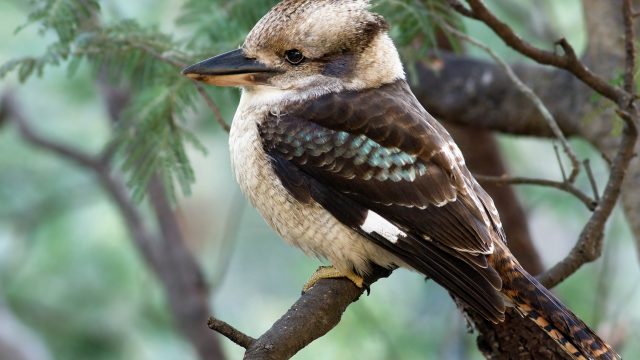People talk a lot about the Wilhelm Scream, and with good reason. It’s a common movie and TV sound effect—I even noticed a few of them in old episodes of Zorro, when I was watching the full series of Zorro (shamefully not available on Disney+) recently. A stranger sound effect, if you think about it, is the cry of the kookaburra, which is one of the single most common sound effects even in quite modern films to represent “you are in a jungle setting now.” And while their habitat does include, per Wikipedia, “humid forests,” they are very specific humid forests. As in, Australian ones. New Guinea as well. But nowhere near as many places as you actually hear them in movies.
So far as I can work out, the first appearance in film of the kookaburra’s call is in the old Tarzan movies. However, the citation I found says it’s 1938’s Tarzan and the Green Goddess, which is actually a reworking of a 1935 serial into a single feature—and the citation said Johnny Weissmuller, but Tarzan here is Bruce Bennett. Who interestingly would go on to be in The Treasure of the Sierra Madre, quite famously set in Mexico, another film which featured the sound of the kookaburra.
Strangely, one of the only movies I personally have seen where you could make an argument for actual existence of actual kookaburras in the place it’s set is the deeply confused island from Swiss Family Robinson, another film in which the sound effect appears. After all, the unnamed family (the “Robinson” is, as in Lost in Space, a play on Robinson Crusoe) was on their way to New Guinea at the beginning of the film, and there are kookaburras in New Guinea. This doesn’t explain the ostrich, the zebra, or the tiger, but never mind. The movie’s vague on where they end up anyway.
Weirder still is that the call of the kookaburra was modified to be the sounds Flipper makes, on the TV show. It is true that, ornithologically, kookaburras are kingfishers. But they’re a genus that isn’t strongly associated with water, and anyway even the average kingfisher spends less time in water than the average dolphin. Still, I would imagine there are plenty of recordings floating around in sound files in Hollywood, and it was probably easier than recording dolphins. You’d keep your microphone from getting wet, for one.
I suspect Spielberg used the call at the beginning of Raiders of the Lost Ark because of its familiarity from serials; when Mystery Science Theater 3000 did Revenge of the Creature, they specifically mentioned the call, and it’s far from the only time it appeared on that show. Possibly that’s why it’s in The Lost World, too. But honestly, I’ve reached the point where the only two continents I haven’t found a documented movie usage for the call are Europe . . . and Antarctica.
Oh, sure; it’s a very distinctive sound. You’ll note I haven’t bothered to link you to it, though if you’re still unsure as to what sound I’m talking about, YouTube is full of examples, and the Wikipedia page has a sound recording. And I’ll even agree that it’s a bit eerie, sounding as it does slightly but not really like a human laugh. I suspect there are few Girl Scouts who didn’t at least once sing “Kookaburra (Sits in the Old Gum Tree),” which I’m pretty sure is in my ’70s and ’80s Girl Scout handbook. Which I still have, by the way. The song’s up there with “Make New Friends.”
I’m sure there are dozens of bird sounds that could be used to interesting effect. The other day, I discovered that we have a rufous-sided towhee living near our house, and that’s not a call you hear a lot of. I’m sure South America and Mexico and Africa and Southeast Asia all have birds with distinctive calls you could borrow, if you wanted interesting local sound effects. But for some reason, what you get is that busy bird the kookaburra.
You don’t get ornithology on the average film site; show that you care by supporting my Patreon or Ko-fi!

